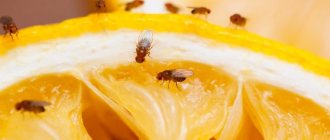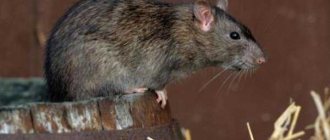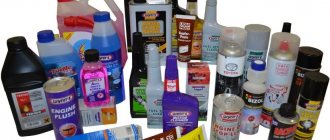House flies often appear in our homes in the autumn and spring. Agree that seeing small pests flying and buzzing around the house is not a pleasant sight. This article will discuss house midges, their types and methods of control.
Types and names
Midges are small two-winged insects that kill people not by their size, but by their number. Neighborhood with such “guests” can result in unfavorable consequences, because midges are carriers of dangerous diseases. And their bites are much more painful, the swelling is much greater than mosquito bites.
When a person is prone to allergic diseases and has sensitive skin, such bites can lead to a severe skin reaction - simulidotoxicosis. Insects reproduce quite quickly; if at first there are only a few of them, then after a short time their number will increase significantly.
Let's look at the most common types:
- Drosophila (fruit midges) - found in the kitchen, flying over fruits and vegetables, sweets and fermented alcohol. They are also attracted to wet rags, dirty trash cans and sinks.
- Midges flying out of kitchen or bathroom sinks are called sewer gnats. They appear fluffy in appearance, as their body and wings are densely covered with dark hairs. Since they appear through the sewer, they are carriers of dangerous bacteria.
- Fungus Gnats – These gnats cause harm to our indoor plants. When you notice that small insects are swarming over the flowers, and the plants look stunted, then these same pests are to blame.
- Clothes moths and food moths - this type of insect can cause quite serious damage to your wardrobe and food products (cereals, flour, etc.).
Here are the main types of midges that are found in our houses and apartments. Some of them do not cause any particular harm to human life, but there are also quite dangerous ones.
Cultivation of soil in pots
If midges have infested flower pots, and you are not sure that the indoor plant will survive replanting, you need to use the previous traps and ways to repel midges, and also start cultivating the soil. There are several solutions that will help with this:
- garlic - rub the garlic head and pour boiling water (0.5 liters) and leave for 2-4 hours. The soil is watered with this solution and the plant is also sprayed. The remaining pulp can be buried to the roots;
- soapy - you need to grate a quarter of the laundry soap, dissolve it in a liter of water, spray the plant once a week;
- sulfur - four matches are stuck into the ground with the head down, replaced every other day. The plant must be watered after each replacement of matches;
- antiparasitic - any antiparasitic product purchased at a veterinary store will do. Dilute according to the instructions in a dosage suitable for puppies and water the plant.
If the plant is able to survive transplantation, then it is better to acquire new land.
Description and photo of what they look like
Drosophila reach sizes from 1 to 3 mm. Their body color can vary, most often being brown and dark yellow. Orange and black colors are much less common. They have 6-8 legs and two symmetrical wings. They do not pose any particular danger to humans and do not bite.
Sewer midges are small black insects.
They pose a danger to humans, namely:
- Their paws carry many dangerous and harmful bacteria. They can spread the disease through food because they like to sit on it, especially if the kitchen counter is located close to the sink;
- cases of allergic diseases occur;
- in the bathroom are dangerous when bathing small children, because they can fly into his mouth, nose or eye.
Fungus gnats are small midges up to 6 mm in size, which at first glance do not pose a threat to humans, but this is not the case. They carry fungal diseases and can cause respiratory illness in humans who have close contact with an infected plant and inhale the spores. They pose a huge threat to indoor plants, as they feed on the juices of the root system. But the greatest danger is posed by the larvae that hatch from eggs laid by the female in the ground.
Food and clothes moths do not cause any particular harm to humans other than damage to property. From the name it is enough to simply determine their habitats.
Food moth. The adult has an inconspicuous gray or dark brown color; the larvae look like small light beige caterpillars and can reach 2 cm in length. The moth feels great in the dark, so it is usually active at night. Her favorite foods are pasta, tea, dried fruits, and cereals. The lifespan of an adult moth (butterfly) is several days. Before this, it goes through the stage of an egg, a wingless larva, a cocoon, and then turns into a butterfly. Moreover, the larva can live up to 60 days. Therefore, the absence of flying insects in your kitchen does not guarantee the purity of the products. The main thing is to periodically check the contents of the containers in which you store bulk supplies.
The clothes moth is a butterfly 5-10 mm long, the larvae of which feed on keratins extracted from hairs of wool, fur, and carpet pile. The peculiarity of this moth species is its relatively long life cycle, with the female laying about 200 eggs throughout her life. The larvae emerging from them at all stages of development, extracting keratin, make holes in things made of natural fibers.
Rating of the best aerosol repellents for midges
Raptor
This aerosol is based on the use of tetramethrin and cypermethrin. Insects can appear not only in a private house, but also in an apartment. Midges are no exception. No one would want to live next door to them. The midge living in the pot lays eggs in the soil of the pot. The Raptor will do an excellent job with the flying and underground inhabitants of the flower tub. This product is also perfect for fighting moths, mosquitoes, fleas, ants and even cockroaches. The brand needs no introduction and is in high demand among European consumers. Supplied in a convenient 275 ml bottle. Despite the fact that the composition is considered safe for humans, the can should be kept out of the reach of children. During storage, it is recommended to give preference to a cool and dark place.
How much does a can cost? The purchase will cost 514 rubles.
Raptor aerosol
Advantages:
- ease of use;
- economical consumption;
- speed of onset of effect;
- wide scope of application;
- value for money;
- functionality;
- patented technology.
Flaws:
- not identified.
Bona Forte
This drug is characterized by an unusual composition and a high efficiency rate. It is based on the use of Dalmatian chamomile inflorescences. An excellent solution in the fight against crawling and flying harmful insects. There is a high speed of impact on midges, without causing addiction. Designed for treating plants in the garden and at home. During the processing process, the risk of the substance getting on the inflorescences and young buds should be eliminated. Such manipulations are carried out in the shade, eliminating the risk of direct sunlight hitting the treated areas of the plant. Available in a 0.5 liter bottle with a sprayer. Subsequent storage should be away from children, in a dark and cool place.
How much does a can cost? The purchase will cost 255 rubles.
Bona Forte
Advantages:
- wide scope of application;
- lightning-fast results;
- convenient form factor;
- does not affect the well-being of the plant;
- can be used throughout the year.
Flaws:
- not identified.
Dichlorvos Neo
This insecticide is available in aerosol form. The composition contains stabilizers, fragrances, cypermethrin, piperonyl butoxide, preservatives, ethyl alcohol and permethrin. The substance belongs to class 3 (moderate) hazardous substances. Effectively fights not only flower midges, but also flies, fleas, ants, bedbugs and even cockroaches. Designed for treating residential premises. Before use, shake the can thoroughly. Sprayed at a distance of 20 cm from the plant. In this case, the temperature regime should be at least +10°C. Such manipulations should be carried out in a well-ventilated area, excluding observers such as animals and children.
Average price – 90 rubles.
Dichlorvos Neo
Advantages:
- wide scope of application;
- affordable price;
- 100% elimination of insects;
- does not affect the health of the plant;
- ease of use.
Flaws:
- processing is carried out in a protective suit and using a respirator;
- At the end of the manipulations, the room is ventilated and completely washed.
Do house flies bite?
At first glance, these little midges look quite harmless and it seems that they will not do us any harm, but in fact they bite more painfully than mosquitoes.
This is due to the fact that during a bite they bite off a piece of flesh, and their saliva entering the wound contains harmful bacteria that cause an allergic reaction, which can manifest itself in different ways:
- the skin at the site of the bite will turn red and be very itchy;
- increased heart rate and increased blood pressure;
- burning and pain at the site of the bite;
- an increase in body temperature, if the bites are not an isolated incident.
When bitten, the first thing to do is wipe the affected area with alcohol, it will help neutralize the poison and relieve discomfort. If the bite site is severely scratched and signs of decay appear, then you need to consult a doctor who can provide you with qualified assistance.
When bitten by a midge, it is strictly prohibited:
- comb the skin at the site of the bite;
- carry out independent treatment with medications without a doctor’s prescription;
- treat the bite site with various household chemicals, as the allergic reaction may intensify;
- Apply the ointment to the wound, as it will cause a burning sensation if it comes into contact. The products are applied around the bite area.
Here are the basic actions and safety measures that need to be taken after a midge bite.
Treatment options
Treatment for a midge bite should begin immediately after a wound or itching sensation is detected.
The consequences of a midge bite can be different:
- severe itching or pain in the affected area;
- increased body temperature;
- swelling of the limbs or wound site;
- skin redness;
- low blood pressure;
- enlarged lymph nodes and pain during palpation;
- rapid pulse;
- weakness of the body;
- feverish condition.
Treatment at home is acceptable if there is slight redness on the skin and mild itching. In other cases, you should consult a doctor to avoid serious consequences.
The manifestation of an allergy to a midge bite depends on many factors: the number of affected skin areas, the age of the victim, individual intolerance to any substances, weather conditions (humidity, air temperature, atmospheric pressure) and others.
How to treat a midge bite depends on what symptoms the victim has and how he feels.
| Symptoms after midge bites | Treatment methods and drugs |
| Skin redness, slight swelling, itching | Treat the affected areas with an alcohol-based solution. Apply antiallergic ointments and gels with a cooling effect to the affected areas: Fenistil, Gioksizon, Cynovit, Prednisolone, Bepanten. |
| Severe allergies, accompanied by swelling of the affected areas of the skin, increased body temperature and weakness of the body | Immediate use of antihistamines such as Tavegil, Claritin, Loratadine, Diazolin and others. Apply alcohol lotions to the affected areas of the body several times a day. Drink plenty of fluids and avoid foods that can cause allergic reactions. |
| A severe allergic reaction to a bite with an increase in body temperature to 39°C, enlarged lymph nodes, tachycardia, low blood pressure, severe weakness of the body, increased sweating, fever, severe swelling. | Taking any antihistamine and immediately going to the hospital. |
How to get rid
The main rule for getting rid of and preventing the reproduction of house flies is cleanliness.
In order to get rid of annoying midges in the kitchen you need to:
- maintain cleanliness and order (wash dishes on time, take out trash on time, periodically check available cereals);
- do not leave spoiled or rotten food;
- Carry out preventive cleaning of the drain using specialized products or vinegar and soda.
To combat fungus gnats, we will need to follow the necessary rules:
- do not flood the plants with water;
- do not throw out leftover tea or coffee;
- When purchasing soil, pay attention to its quality.
The above methods also include specialized means for controlling small pests, which you can purchase in stores or on the market.
Varieties
You don't need to be a biologist to know that individuals of each species may have external differences, according to which they are divided into subspecies.
The insects in question have their own varieties.
Different hereditary forms of the Drosophila fly
Drosophila are:
- Black Drosophila.
- Fruit Drosophila.
- Flightless Drosophila.
Whitefly happens:
- Greenhouse whitefly.
Whiteflies - Citrus whitefly.
- Strawberry whitefly.
- Cabbage whitefly.
- Tobacco whitefly.
Sciarids are also divided into subspecies:
- Licoriella.
- Bradysia.
These two species can most often be found in Russia, where 96 subspecies of these insects have been recorded.
Traditional methods
You can use traditional methods to combat midges.
These include:
- Vacuum cleaner . With its help, you can get rid of midges; to do this, you need to turn it on at full power and direct the suction tube to places where insects accumulate. It is recommended to clean the container or bag away from the house so that they do not return.
- Smoking out midges is another method of control that has proven itself. To do this, we need a piece of camphor (a white crystalline substance used as a medicine), which must be crushed and placed on a roasting pan. As soon as steam appears, you will need to take a brazier and walk around the home. House flies hate it, but it is safe for humans and pets.
- Homemade traps . Can be made from a plastic cup or jar. To begin with, place pieces of sweet fruit on the bottom or pour in a little juice, wrap the top of the neck with cling film and make several holes through which insects will penetrate. We leave it overnight, and in the morning you will be surprised how many midges have got there.
What to do if these insects are in your home?
Below are step-by-step instructions for exterminating household pests:
- It is necessary to place mosquito nets on all windows, the size of the holes in which will be minimal. If there are no mosquitoes on the windows yet, try not to open the windows so that the insects do not fly in from the outside.
- Eliminate all potential sources of excess moisture in your home. Do not flood pots with plants, wipe the sink dry after each use, and ventilate the bathroom well.
- Set up homemade traps with vinegar, fruit juice and midge detergent. Place one of these devices in each room. Replace these traps once every few days.
- Dip a piece of fabric into pine oil, then place the pieces next to each window and doorway. The smell will repel pests and they will not be able to enter the room.
Why do they start
Basically, small pests are caused by a person’s failure to comply with hygiene rules and pollution in the house. Mature individuals lay eggs on ripe fruits, and when we bring home vegetables and fruits, we also bring the eggs of these insects along with them. They need a rotting environment to develop, so as soon as the fruit begins to deteriorate slightly, the process of midge development from egg to adult will begin. Their life cycle is short, and their ability to reproduce is amazing. In a relatively short period of time they turn into a huge swarm.
Let's get to know each other better
Unless you look at this insect under a microscope, it is difficult to distinguish it from an ordinary clothing moth. And its larvae are very similar to maggots - fly larvae. White worms with dark heads several millimeters long.
Each moth lives only a few days, a maximum of two weeks, but even in such a short time it manages to hatch a huge number of larvae, which ruin our lives.
Where do food moths come from?
Since this is a flying insect, it can easily enter your home through a door, window or ventilation duct from your neighbors. But much more often we bring its larvae home with our own hands along with food. They can be found in cereals, flour, nuts, dried fruits and even candies.
Moth larvae in candy
The cause of food contamination by food moth larvae is poor processing and improper and very long-term storage. White worms in the kitchen quickly turn into butterflies and begin to multiply, multiplying exponentially.
Are food moths and their larvae harmful?
It is believed that adult moths - both food and ordinary - do without food, they only need water. Whether this is true or not, it is impossible to say for sure, because insects are often found in foods left on the table, especially sweet ones. But even this could not be paid much attention to if the moths did not multiply so rapidly.
Worms appearing on the ceiling in the kitchen are a sure sign that moths have been living with you for a long time and have already managed to cause enormous damage to your food supplies. She herself may not eat, but her offspring are incredibly voracious.
Photo of food moth larvae
The food itself is not only eaten, but also contaminated by dead caterpillars, their feces and skins remaining after degeneration into adults. It is very unpleasant to see such a picture, even filmed on video, not to mention cooking porridge from such cereals or compote from dried fruits.
Therefore, if white worms appear in the kitchen, you need to get rid of them urgently.
Prevention
To prevent midges from appearing in your home, you must follow a small set of rules, namely:
- systematically carry out general cleaning and frequently take out the trash;
- store all food products only in the refrigerator, since midges do not develop in a cold environment;
- all fruits and vegetables brought into the house should be thoroughly washed with hot water to get rid of eggs;
- systematically clean the sewer and eliminate excessive moisture;
- get rid of spoiled food in a timely manner, and thoroughly wash the place where they were stored;
- properly care for house plants, change the soil on time and do not over-water it.
By following all the above rules, you will eliminate the possibility of midges appearing in your home and protect your life.
Causes of parasites
Experts believe that the main reason for the appearance of midges is improper care of indoor flowers. The main mistakes that are made are:
- The appearance of insects in the house with a new flower. Before installing a new acquisition next to the “old-timers”, it is necessary to quarantine it. Time will tell what is in the soil. If pests and diseases are present, they will manifest themselves within two weeks. It is worth taking certain safety measures. You need to think about how to get rid of parasites. Only after complete cleaning can the pot be placed on a common windowsill.
- Application of organic fertilizers. Some people prefer to feed their pets with humus, granulated sugar, leftover tea and coffee, and yeast. On the one hand, the flowers are provided with nutritional components, on the other hand, the process of decay of the organic composition begins, which becomes an ideal environment for the appearance and reproduction of pests.
- Waterlogging of the soil. Watering plants too frequently and abundantly is not recommended. Especially if the pot does not have good drainage. This also applies to greenhouses for growing flowers from seeds. Do not water the soil abundantly in winter, even if the room is too hot.
- Application of contaminated soil. Pests can be found everywhere, so there is a possibility of their presence in any soil. Before planting a sprout in the soil mixture, it must be disinfected.
Midges can be caused by open windows. It is impossible to completely eliminate the appearance of pests, no matter how hard you try, so it is necessary to take preventive measures and prevent significant reproduction of insects.











